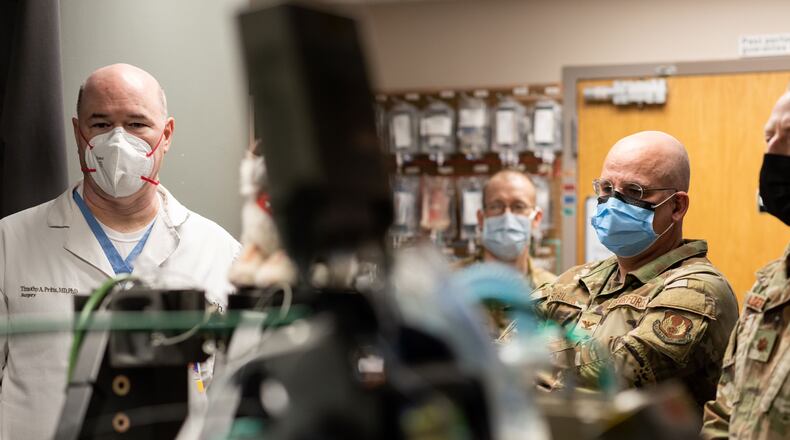C-STARS is a training program at UC that prepares Air Force medical professionals.
Planned is an expanded, $10 million simulation center that advocates say will modernize readiness training, incorporating lifelike manikins, virtual reality simulations and performance analysis.
It will allow the training of 300 CCAT (Critical Care Air Transport) teams annually, compared to 108 today, “ensuring the Air Force can respond effectively to future conflicts and mass casualty events,” UC Health said.
“This transformative $10 million initiative confirms the partnership’s commitment to preparing Air Force medical personnel to deliver critical care worldwide,” the university said.
In an interview Tuesday, Col. Valerie Sams, director of C-STARS Cincinnati and a volunteer associate professor in the Department of Surgery at the UC College of Medicine, said the new center will be located in an existing facility at the Ridgeway Tower, part of the UC Health campus.
The story of how Air Force and UC health care providers were able to help Hamlin after he nearly died on national television in a January 2023 game between the Buffalo Bills and the Cincinnati Bengals held the nation’s rapt attention, generating stories everywhere from ESPN to the New York Times.
The proposal for federal funding for the expanded center was submitted well before that game, Sams said. The proposal was for $7 million; the 711th Human Performance Wing ended up receiving $10 million for the expansion.
“I will say I think the continued demonstration of the strength of the partnership we had with UC Health definitely played a role in that,” Sams said. “In everything that continues to illustrate the importance and success of that partnership, it certainly played a role in how these funds were probably pursued, but also how we got the additional funds.”
The wing is managing the expansion.
Sams expects students to come from all over the Air Force to train at the center, with researchers from AFRL and Wright-Patterson having a place there, as well.
“This investment underscores our commitment to continuous improvement and readiness in aeromedical evacuation and critical patient care, ensuring we can respond to medical emergencies globally,” said Col. Tory Woodard, commander of the Air Force School of Aerospace Medicine, which is based at Wright-Patterson. “These military-civilian relationships are critical to our nation, helping train our medics and sustain the skills needed for our operational missions. This expansion helps us prepare for the next generation of aeromedical evacuation and critical patient care.”
UC Health has hosted the C-STARS program since 2002. The partnership has trained nearly 5,000 professionals in that time.
“During my time as a surgeon in Iraq, CCAT ensured that the work we did in theater was completed at our bases in Germany, and back in the U.S., saving the lives of so many service members,” said U.S. Rep. Brad Wenstrup, R-Cincinnati. “By investing in the already successful partnership between Wright Patterson Air Force Base and UC Health, we can make this program the model for any high-level national response, while also improving the training programs for our service members so they are best prepared for the high-intensity operational mission.”
About the Author


